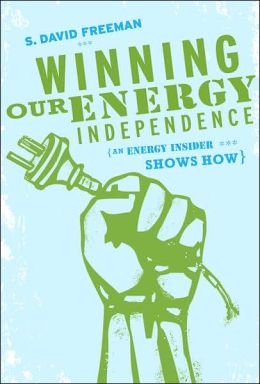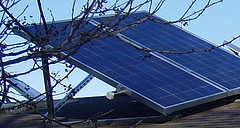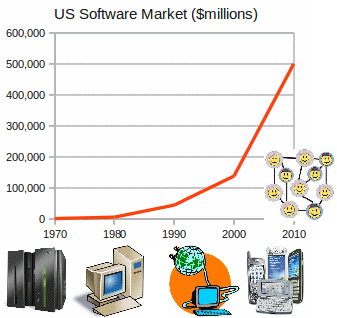You might think these solar panels covered with snow weren’t generating anything:
But they are. Not much, true, but they are generating: Continue reading
You might think these solar panels covered with snow weren’t generating anything:
But they are. Not much, true, but they are generating: Continue reading
Will you bet on the blinkered money-only policies of the current TVA Chair, or the accurate clean solar future predictions of former TVA Chair S. David Friedman?
Seven years ago S. David Friedman wrote:

“As a substitute for oil, coal, and nuclear energy, the sun can replace the three poisons with inexhaustible fuel.”
The former TVA Chairman wrote that in 2007 his boook Winning Our Energy Independence: An Energy Insider Shows How, which also says (page 4):
There are breakthroughs in new technology that promise to make the cost of solar power as low as that of coal, nuclear, and oil. Almost simultaneously in South Africa and the Silicon Valley in the United States, companies are building huge new solar factories to manufacture a paper-thin solar coating that can generate electricity that could actually lower our electric bills. These breakthroughs promise solar power at 75 percent less than today’s price. Continue reading
This month’s eia report confirms that solar did exactly what former FERC Chair Jon Wellinghoff predicted: “That’s what is happening in solar. It could double every two years.” Wellinghoff’s further prediction remains on the money: “…at its present growth rate, solar will overtake wind in about ten years. It is going to be the dominant player.” Because of exponential growth like compound interest caused by ever-falling solar PV costs, solar will win like the Internet did.
U.S. Energy Information Administration (eia) wrote 22 April 2014, Solar-electric Generating Capacity Increases Drastically in the Last Four Years,
U.S. solar capacity increased significantly in the last 4 years. In 2010, the total solar capacity was 2,326 MW which accounted for a comparatively small fraction (0.22%) of the total U.S. electric generating. capacity. By February 2014, this capacity increased 418% to 12,057 MW, a 9,731 MW gain, and now accounts for almost 1.13% of total U.S. capacity. Reported planned solar capacity additions indicate continued growth
12,057 / 2,326 = 5.18 times, which is more than 2 * 2 = 4, ergo Wellinghoff was right. Continue reading
Colorado, California, North Carolina: when will Georgia catch up in solar power? What will it take to get the Georgia legislature to realize all Georgians will benefit economically from much more solar power than GA PSC in July required Georgia Power to buy? And why should we permit a methane gas pipeline to gash through Georgia to profit executives in Houston and Juno Beach, Florida when we could be deploying solar everywhere in Georgia for local jobs, profit, lower electric bills, and clean air and water?
Here’s the study that showed solar benefits outweigh costs in North Carolina, The Benefits and Costs of Solar Generation for Electric Ratepayers in North Carolina, by R. Thomas Beach and Patrick G. McGuire for Crossborder Energy, 18 October 2013.
Wholesale solar PPA prices provide perhaps the most dramatic evidence of the continued decline in solar PV costs. Solar PPA prices have fallen dramatically over the past several years, to the point that, in some regions of the U.S., solar is now competitive with other generation resources, including wind and natural gas. Xcel Energy in Colorado recently announced that it is proposing to add 170 MW of utility-scale solar to its system, with its CEO stating “[f]or the first time ever, we are adding cost competitive utility scale solar to the system.”33 The California electric utilities make public each year the average PPA prices for renewable contracts approved by the CPUC in the prior year. Figure 3 shows the trend in the prices for their solar PV PPAs; CPUC contract approval can occur up to a year or more after bids are received, so the figure is indicative of prices through roughly 2011.34 2012 solicitations for solar PPAs in California in the 3 MW to 20 MW size range through the Renewable Auction Mechanism (RAM) have yielded market-clearing prices in the 8 to 9 cents per kWh range.3
The Lawrence Berkeley National Lab (LBNL) conducts and publishes regular national surveys of the installed costs of solar PV; these surveys include Continue reading
 Moore’s Law for solar is about decreasing price per Watt,
or more Watts per dollar.
Here’s an example of a common confusion, to think it’s about efficiency:
Moore’s Law for solar is about decreasing price per Watt,
or more Watts per dollar.
Here’s an example of a common confusion, to think it’s about efficiency:
“The curve will obviously become asymptotic at some point, ie,. the rate of improvement will flatten out, so we end up with a sort of squashed “S” shape curve, because you can’t get more than 100% efficiency — 36 watts/m2 or so.”
And indeed efficiency probably will flatten out soon. But it’s not solar efficiency that’s improving by Moore’s Law: it’s price per watt. That can keep improving for a long time.
Here’s an example of decreasing price. Scott Detrow wrote for NPR 23 December 2012, Forget Fracking: 2012 Was A Powerful Year For Renewables,
“Just to give you perspective,” Resh said, “in Washington, D.C., where I live, when I installed solar on my house six years ago, the average install cost was about $14 a watt. Today it’s about $4 a watt.”
Here’s another comparison, this one just for solar panels.
 In 2005 the first set of solar panels we got cost $670 each
and produced 170 Watts DC each, or $4.94/Watt.
In 2011 our second set of solar panels cost $562 each
for 235 Watts DC each, or $2.39/Watt.
That’s more than 50% price decrease for solar panels in six years.
(I can’t compare inverters or support structures directly,
because those were sized so differently, but those have also
come down in price, helping lower the overall install cost).
In 2005 the first set of solar panels we got cost $670 each
and produced 170 Watts DC each, or $4.94/Watt.
In 2011 our second set of solar panels cost $562 each
for 235 Watts DC each, or $2.39/Watt.
That’s more than 50% price decrease for solar panels in six years.
(I can’t compare inverters or support structures directly,
because those were sized so differently, but those have also
come down in price, helping lower the overall install cost).
| Year | price /Watt | price /panel | Watts /panel | Dimens. | square inches | Watts /100 sq in. | Model |
|---|---|---|---|---|---|---|---|
| 2005 | $4.94 | $670 | 170W | 50×39″ | 1950 | 8.7 | KC 170 |
| 2011 | $2.39 | $562 | 235W | 39.1×64.6″ | 2525 | 9.3 | Sharp ND 235 QCJ |
| 2012 | $1.32 | $310 | 235W | 39.1×64.6″ | 2525 | 9.3 | Sharp ND 235 QCJ |
Meanwhile, the Watts per surface area hardly changed, from about Continue reading
Many people are unfamiliar with Moore’s Law, and how it affects solar power. Moore’s Law doesn’t occur in many technologies or industries, but it’s there in solar photovoltaic (PV). For those of us whose whole working lives have been affected by Moore’s Law, seeing it turn up in another field is like a flashing neon sign pointing to the future. A future of distributed solar power sunrise over the crumbling industrial relics of coal, nuclear, and natural gas plants. A future with much less control by monopoly utilities, which is why they fight it. If they even see it coming; Bill Gates didn’t, back in the day, but Jeff Bezos of Amazon did. They both surfed that tide, and Moore’s Law made both of them among the richest humans on the planet while changing the world for all of us. Steve Jobs even used it to put a computer in your pocket more powerful than big companies could buy a few decades ago. What does Moore’s Law for solar power mean for electric power?
This chart shows the telltale symptom of Moore’s Law in solar electricity: 65% compound annual growth rate in solar power plants deployed for the past 5 years:
Source: Solar Power Graphs to Make You Smile by Zachary Shahan for CleanTechnica 10 June 2011.
As SunPower’s Dinwoodie puts it:That 17 GW installed in 2010 is the equivalent of 17 nuclear power plants — manufactured, shipped and installed in one year. It can take decades just to install a nuclear plant. Think about that. I heard Bill Gates recently call solar “cute.” Well, that’s 17 GW of “cute” adding up at an astonishing pace.
 Bill Gates should recall that Moore’s Law made formerly “cute” PCs with his
“cute” operating system Windows expand into every company in the world
and made him the second richest human on the planet.
Growth of computer software markets,
like for the U.S. as shown in the graph on the right,
is a symptom of the original Moore’s Law.
Software runs on hardware, and these hardware market curves
are driven more directly by Moore’s Law:
Bill Gates should recall that Moore’s Law made formerly “cute” PCs with his
“cute” operating system Windows expand into every company in the world
and made him the second richest human on the planet.
Growth of computer software markets,
like for the U.S. as shown in the graph on the right,
is a symptom of the original Moore’s Law.
Software runs on hardware, and these hardware market curves
are driven more directly by Moore’s Law:
 Two professors in India have done the math and found that
there’s plenty of available land in India (much of it on rooftops)
to power its billion people on solar energy alone.
And solar uses less water than nuclear or coal, also as we already knew for the U.S.
Two professors in India have done the math and found that
there’s plenty of available land in India (much of it on rooftops)
to power its billion people on solar energy alone.
And solar uses less water than nuclear or coal, also as we already knew for the U.S.
Today in The Hindu, India can meet energy needs sans N-power: Study,
According to their study, 4.1 per cent of the total uncultivable and
waste land area in India is enough to meet the projected annual demand of 3,400 terawatt-hour (TWh) by 2070 by solar energy alone (1 terawatt-hour per year equals 114 megawatts). The land area required will be further reduced to 3.1 per cent “if we bring the other potential renewable energy sources of India into picture”, they claim. They conclude that land availability is not a limiting constraint for the solar source as believed. According to their study, 4.1 per cent of the total uncultivable and waste land area in India is enough to meet the projected annual demand of 3,400 terawatt-hour (TWh) by 2070 by solar energy alone (1 terawatt-hour per year equals 114 megawatts). The land area required will be further reduced to 3.1 per cent “if we bring the other potential renewable energy sources of India into picture”, they claim. They conclude that land availability is not a limiting constraint for the solar source as believed.
The graph above shows land occupation needed to generate 1 gigawatt hour (1GWh) for each of coal, nuclear, hydroelectric, and solar. It is Figure 3 from the actual study, Is land really a constraint for the utilitzation of solar energy in India? by H. Mitavachan and J. Srinivasan, Current Science, Vol. 103, No. 2, pp. 163-168, 25 July 2012. More from the Hindu article, with graphs from the journal article:
Continue reading Stewart Brand of Whole Earth Catalog fame is a long-time environmentalist
who in recent years decided nuclear was necessary.
(He also decided
no-till was necessary, which was enough
to convince me he’s gone barmy.)
Here
at TED
he debates Mark Z. Jacobson,
whose new study says we can
power the world with wind, water, and sun.
I think Jacobson should reconsider including building more hydroelectric dams,
but his study does demonstrate that we don’t need nuclear or biomass.
But watch it and see what you think:
Stewart Brand of Whole Earth Catalog fame is a long-time environmentalist
who in recent years decided nuclear was necessary.
(He also decided
no-till was necessary, which was enough
to convince me he’s gone barmy.)
Here
at TED
he debates Mark Z. Jacobson,
whose new study says we can
power the world with wind, water, and sun.
I think Jacobson should reconsider including building more hydroelectric dams,
but his study does demonstrate that we don’t need nuclear or biomass.
But watch it and see what you think:
Here is my critique of Brand’s arguments: Continue reading
Here’s a four page explanation of that table.
Coal is not the cheapest: natural gas is. Onshore wind actually costs about the same as coal, and less than nuclear. Offshore wind is currently about 2.5 times more expensive.
Solar photovoltaic (PV) currently costs a bit more than twice as much as coal, and already less than offshore wind.
The table does not take into account the environmental costs of the various power sources, or obviously coal would fare far worse, and biomass would not be rated anywhere near as good as wind.
Remember, the cost of solar is falling rapidly, so solar will rapidly become more cost-effective compared to other energy sources.
-jsq
Solar may not be the most affordable power source today, but wait a few years and it will be. Or get on with organizing the political and corporate structures to be ready. In sunny south Georgia, solar is our best bet.
-jsq